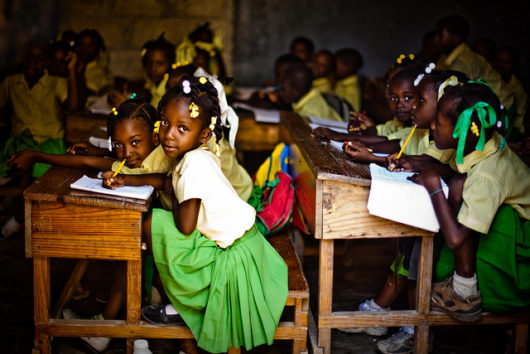Top 10 Facts About Girls’ Education in Haiti

Education reform in Haiti has provided opportunities for women and young girls to escape the conditions of extreme poverty in the country. However, girls continue to struggle in getting an affordable education and traditional gender norms challenge the potential opportunities for women. Haiti ranks 177th out of 186 countries in the world in terms of national spending on education. Advocating for the benefits of education for young girls can break these barriers. In the text below, the top 10 facts about girls’ education in Haiti are presented.
Top 10 Facts About Girls’ Education in Haiti
- Girls have shown an increase in primary school enrollment. From 2008 to 2012, primary school attendance for girls has grown to 77.7 percent compared with boys at 76.7 percent.
- Haiti’s education system has some challenges as ineffective teaching methods contribute to low-quality education. In addition, there is a persistent shortage of qualified teachers who remain unpaid. Around half of the public sector of teachers lack basic qualifications, 80 percent of them have not received any pre‐service training and 25 percent have never had a formal education or have attained a secondary school.
- The 2010 earthquake left Haiti in shambles and further damaged already-weak school infrastructure. The earthquake destroyed 4,000 schools, including one of the biggest educators of Haitian women and girls, the Sisters of St. Joseph of Cluny. Schools have struggled to provide students with a quality education. In some instances, children aged 5 to 12 attended classes in one-room local churches. Following the earthquake, these were temporary measures to shelter student so they could resume their schooling.
- Educate a Child is an organization that implemented a project called Quality Basic Education for Out of School Children (OOSC) with the goal to increase access to education by building primary school options in Haiti, as well as expanding them. The project’s goal is to reach at least 50,000 school children or OOSC within the following sub-groups of girls and boys: in domestic servitude situations, in rural and semi-rural areas, in rural farm situations without economic means to attend school and in street or semi-street situations. Currently, there is one OOSC program in Haiti. The project benefits parents of OOSC, teachers, school officials and an estimate of 227,000 children.
- Young girls with little or no education are more likely to have children and be victims of domestic violence. About 70 percent of women in Haiti have been victims of gender-based domestic violence. One survey found that 13.1 percent of girls and 14.6 percent of boys between the ages of 10 and 14 who were not enrolled in school were among the estimated 150,000 to 500,000 children who lived with non-relatives as unpaid domestic servants, and 65 percent of them being girls. Girls who are unable to attend school go to domestic labor and become vulnerable to physical, sexual and psychological abuse, unlike the girls who finish primary and secondary school who are more likely to escape these conditions and marry later in their adult years.
- Gender discrimination continues to be an obstacle for girls seeking access to education. Children from the ages of 5 to 17 work as unpaid domestic laborers. These children are also called restavek, and the majority of them are girls. Though girls enter school on par with boys, they are marginalized and are subject to higher dropout rates.
- Most Haitian schools follow French education model and French is used on the national tests. This creates a language barrier since most Haitians speak Creole. Less than 22 percent of Haitian primary school children pass the entrance examination at the end of grade five. About 13 percent of girls succeed in these entrance exams, while the rest are ill-prepared and unable to proceed to secondary school.
- The literacy rate is approximately 61 percent- 64 percent for males and 57 percent for females. Haiti Now is an organization committed to investing in accelerated educational programs for girls vulnerable to domestic servitude and at risk to drop out. They build on literacy skills by distributing and purchasing textbooks for young girls. As of 2016, 7,246 textbooks have been distributed to classrooms throughout Haiti and 425 girls have been recipients to textbooks.
- Malnutrition and natural disasters pose an obstacle for girls to stay in school. The World Food Program (WFP) delivers daily hot meals to about 485,000 school children in over 1,700 predominantly public schools throughout Haiti. WFP found that girls’ education contributes to a 43 percent reduction in child malnutrition over time, while food availability accounts for 26 percent reduction. For families who struggle to provide food at home, food programs in school also ensure that girls stay in school and are focused and ready to learn.
- The access to primary education in Haiti has improved with 90 percent of primary school-aged children enrolled in school to date. Although these changes are an improvement in Haiti’s education system, quality education remains a challenge. Many students repeat a grade and about 53 percent drop out before completing primary school, while 16 percent of girls stop attending primary school altogether.
These top 10 facts about girls’ education in Haiti demonstrate how barriers are broken and how conditions continue to improve for girls that are eager to learn. However, gender discrimination continues to be an obstacle to Haiti’s development in education. Despite these inequities, women in Haiti continue to be the necessary leaders, caregivers, professionals and heads of households by serving their communities and responding in times of crisis. As Haiti continues to rebuild, it will be critical to providing educational opportunities for the current generation of girls to ensure sustainable development efforts are met.
– Luis Santos
Photo: Flickr
